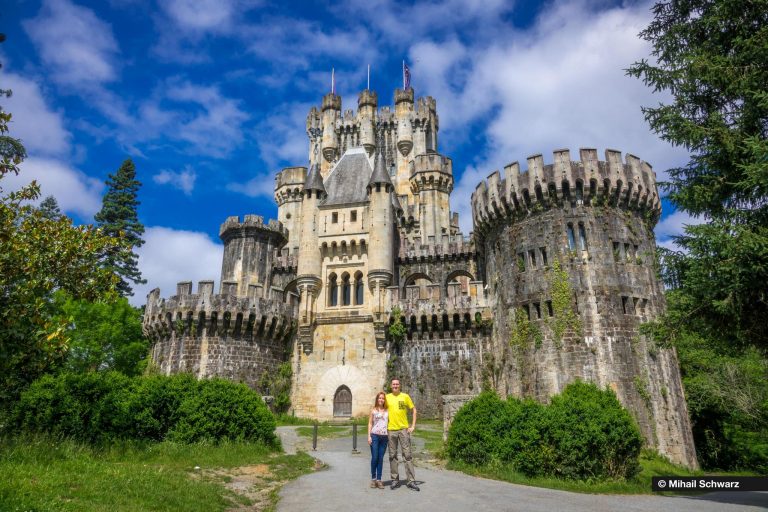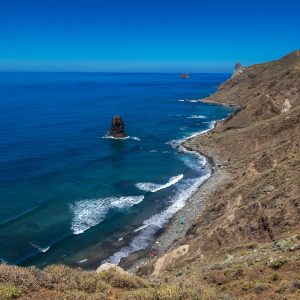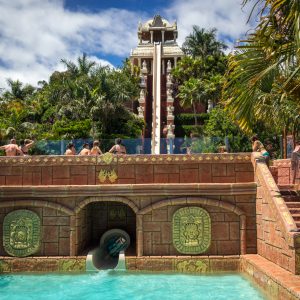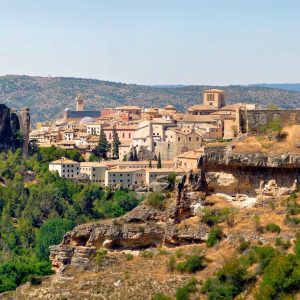Spain, thanks to its rich and rich history, is considered a country of castles and fortresses. Today there are more than 2500 of them, and 500 of them are in excellent condition. These formidable fortifications impress with their power, grandeur and luxury. My selection includes only the most interesting of them.
Castle Butrón / Castillo De Butrón

The neo-Gothic Castillo de Butrón is located in the Basque Country, 19 km north of Bilbao. The majestic structure stands on a hill near the river, in the middle of a lush park and oak groves, and is reminiscent of the “fairytale” castles of Ludwig of Bavaria.
Its history dates back to the 10th century, when the ancestor of the Butron feudal family built a round tower on this site. The family estate was repeatedly rebuilt and strengthened. In the XIV century it was an impregnable fortress with a moat, and in the XV century it was an ordinary residence of the nobility. The castle acquired its present appearance in the 19th century, when it was reconstructed in the romantic style in the spirit of Bavarian castles. The rebuilt Butron looked impressive, but became uncomfortable to live in. It had many open areas and passages, four-meter-thick walls and too little living space.
Today Butron is available only for external inspection. The castle is in a deplorable condition. It has been overrun by the forest, the towers are overgrown with moss, and some of the windows are broken. Nevertheless, since 1949 it has had the status of a historical heritage site and is protected by the state.
Templar Castle In Ponferrada / Castillo De Los Templarios

The town of Ponferrada is famous for its medieval castle (Castillo de Ponferrada), otherwise known as the Templar Castle (Castillo de Los Templarios). The castle stands on a high hill at the confluence of the Boeza and Sil rivers. Its purpose was to guard the pilgrims on the route of St. James.
The history of the castle began in 1178, when the Knights Templar Order received permission from King Ferdinand II of Leon to build a fortress. Over the centuries, Ponferrada Castle changed its owners many times, and each time it was expanded and strengthened. But in XIX century it began to fall into decay: cattle grazed in the yard, soccer was played, and the walls were slowly dismantled for building materials. In 1924, after the Ponferrady castle was declared a national monument, its restoration began.
The Templar castle is surrounded by a moat and is polygonal in shape. On the city side the line of defense is double, and on the river side – single. The structure consists of two parts: the old and new castles. The Old Castle is the oldest part, built in the XII century. The New Castle, also called the Palace, has dining and armory halls, storerooms and stables. Today the ancient walls house a research center and library of the Templar Order, and on the first full moon in July, the modern Templars hold their feast here.
Castle Loarre / Castillo De Loarre

The Castillo de Loarre , built in Romanesque style, is the oldest defensive structure in Spain. However, it is well preserved. The castle stands on the Loarre hill 35 km from Huesca.
It is believed that the castle was built in the first half of the 11th century by order of King Sancho III as a frontier outpost on the Arab-Christian border. But excavations show that the fortification existed here already in 1035. In the second half of the 11th century the castle was inherited by King Sancho Ramirez and turned into a monastery of Augustinian canons. Then it was a royal residence and in the 19th century it became a refuge for shepherds and livestock.
The Loarre has been expanded, reconstructed and rebuilt many times. From the Middle Ages survived strong fortress walls, numerous towers built at different times, courtyard with a well, ancient chapel and crypt. The interiors of the castle have not survived, but it is worth going inside to see the halls, climb the main tower and see from a height the plain of Hoya de Huesca and the ruins of the old Muslim fortress of Bolea.
Alcázar In Segovia / Alcázar De Segovia

On top of the rocky cliffs above Segovia stands the ancient Alcázar de Segovia . Reflecting in the waters of the Eresma and Clamores rivers, it looks like a ship sailing through a sea of dark green trees. The pointed domes of its towers resemble tall ship’s masts.
In Roman times there was a wooden fortification on the hill. In the eighth century, the Arabs built the first stone structure here. In the twelfth century, Alfonso VI and his army entered Segovia and from then on the Alcázar became the residence of the Catholic kings. King Alfonso VIII rebuilt the Arab fortress in the Romanesque-Gothic style. Most of the towers, interior rooms and underground passages were built during the Middle Ages.
Since 1953, the Alcázar was given the status of a museum. Today, tourists can visit the Juan II Tower and 11 magnificently decorated halls.
The Castle Of The Kings Of Navarre In Olite / Palacio Real De Olite

The Castle of the Kings of Navarre (Palacio Real de Olite), also called the Royal Palace of Olite, is a civil rather than a military structure. It is a complex ensemble of French Gothic courtyards, towers, galleries, corridors, passages, and gardens. The former residence of King Charles III the Noble of Navarre was built in the 15th century on the site of medieval fortifications. It was huge and one of the most luxurious palaces in Europe, though built in a somewhat chaotic way as there was no unified architectural plan. In the 16th century, after the conquest of Navarre by Spain the castle was abandoned and began to decay. After several centuries of neglect during the Franco government, it was rebuilt.
In the castle you will see the Royal Suite and the Queen’s Garden, the famous Hanging Gardens, the Arches and Bat Hall, climb several towers, see an exhibition dedicated to life in the court of Charles III, visit a medieval fair and enjoy a performance at the Classic Olita Theater Festival.
Castillo De Coca

The Castillo de Coca is a grandiose Mudejar-style defensive structure located in the town of Coca, Segovia province. It was built in the fifteenth century under Archbishop Alonso Fonseca. The light brick was used as a building material, which was laid out at different angles, resulting in extraordinary ornaments.
The castle has a rectangular shape. It is surrounded by a deep dry moat and a double fortress wall with corner towers, corridors and gates. About 200 m of the 12th century fortification wall, as well as gates and 3 towers, have been preserved to this day. The building belongs to the Alba family, who gave it to the state for use. Today it houses the school of forestry.
In the castle it will be interesting to see the brick patterns, luxurious interior, ceramics, carpets, armory, dungeon and archaeological finds stored there.
Castillo De Peñafiel

The history of Castillo de Peñafiel goes back to the ninth century. But it owes its present appearance to Pedro Hiron, Master of the Order of Calatrava and ancestor of the Teles Hiron family, who rebuilt and reconstructed it in the fifteenth century. The castle looks like a ship anchored on a Castilian plateau. It dominates the valleys of the rivers Duero and Duratón. This made it one of the bastions of defense during the Reconquista. Only small details of the 11th-14th century citadel have survived. In 1917 Peñafiel was declared a national monument.
The castle has an elongated shape. Its length is 210 m, width 35 m. Along the powerful fortress walls you will see 28 defensive towers. In the center there is a rectangular, massive tower 34 m high, the top of which offers a beautiful view of the Ribera del Duero and the village of Peñafiel.
In 1999, the Provincial Museum of Wine (Museo Provincial del Vino de Valladolid) was opened within the walls of the castle.
Castle La Mota / Castillo De La Mota

The size of the fortress and its core-strewn walls and towers are impressive. The historic interiors of the interior of the castle have been largely lost, but the overall architectural appearance has been restored. The crenelated walls, mighty towers lined with red and white Toledo-style bricks, and parapets decorated with ornamental wattle-and-daub ornaments will delight fans of medieval architecture. In the eastern part of the castle are galleries, ceremonial halls and chambers of the monarchs. Many of the rooms have access to the underground passage. In the west wing are the main courtyard, outbuildings, and prison cells.
Today, La Mota Castle is protected by the state as a cultural heritage site of Spain. Various cultural events are held there.
Castillo De Manzanares El Real

The Castillo de Manzanares el Real is an example of a Spanish fortification of the 15th century, a symbol of the once powerful Castilian Mendoza family. The fortress stands on the southern slope of the Sierra de Guadarrama, 50 km from Madrid. This is the second fortress in the area. The ruins of the old one (XIV century) can be seen nearby.
The new castle of Manzanares el Real was begun by Don Diego Hurtado de Mendoza in 1475. The architecture traces the Isabelino style with Spanish-Muslim influences. It is a square building with three cylindrical and one square corner tower, surrounded by a battlemented wall with loopholes in the shape of the Jerusalem Cross. The inner courtyard is called the “Patio de Armas”, the Armory. The castle is decorated with the heraldry of the Mendoza family, coats of arms of Velasco and Toledo.
The interior is decorated in the style of a luxurious palace with a series of spacious halls arranged around a courtyard. The interior is decorated with Flemish tapestries of the 17th century, paintings and furniture of the 16th and 19th centuries. The castle contains a rich collection of ancient weapons and armor.
Manzanares el Real was the possession of the Mendoza family until 1565. After the death of the fourth duke, conflicts between the heirs began. The castle fell into disrepair. Its restoration began in 1914. In 1931 the castle passed under the patronage of the state, and in 1977 it was opened to the public. Today, seminars, concerts and excursions are held there.
Castle Almodóvar Del Río / Castillo De Almodóvar Del Río

Almodóvar, like any self-respecting castle, has its own ghost. It is Princess Zaida, who has been wandering around the castle every year on March 28 for more than 900 years, waiting for her dead husband, Fath al-Mamoun.
The restoration of the castle began in 1901. The castle was restored to the state in which it was in the XIV century. In 2001, it was opened to the public. Now guided tours, cultural and ceremonial events, costume shows are held there. Inside, there is a restaurant where dishes are served by waiters in national costumes and do not serve cutlery. From the castle towers you can see the vast fields, the Sierra Morena mountains, the city of Almodóvar del Rio spread out below, and on a clear day you can see the snow-capped peaks of Granada.
Almodóvar del Río Castle was the setting for several episodes of Season 7 of Game of Thrones. In the story, the Tyrell ancestral home of Highgarden was located here, as well as parts of Casterly Rock, the ancestral home of House Lannister.





